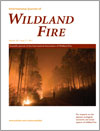International Journal of Wildland Fire
Volume 20
Number 7 2011
We examined the relationship between fire likelihood and some of its key environmental controls at multiple spatial scales. Results indicate that controls operate at different scales and that the influence of some explanatory variables masks the effects of others. This study demonstrates the value of a multi-scale approach for characterising mechanistic controls on fire likelihood.
We quantified and compared the amount of carbon consumed during and remaining after fire in forests burned after long v. short intervals. We found evidence of an additive loss of carbon following two closely timed fires, resulting in a much greater total reduction in carbon relative to pre-fire or unburned conditions in mature stands.
We describe the spatial and temporal variability in post-fire trace gas (carbon dioxide, methane and nitrous oxide) flux rates. We used a likelihood approach to evaluate the strength of support in the data for all possible combinations of the local- (e.g. fire severity) and landscape-scale variables (e.g. time since fire).
N2O fluxes and related microbial processes were investigated in a burned Mediterranean shrubland. Burning stimulated nitrification activity and N2O production during the first year post-fire. In the same period, the ratio of autotrophic- to heterotrophic-derived N2O emission increased in burned plots probably stimulated by the significant increase of soil NH4+.
The little-known long-term effects on soils and plants of three chemicals added to water for wildfire-fighting were studied 5 years after a prescribed fire. Only the ammonium polyphosphate chemical had clear effects: (i) higher P and inorganic-N concentrations in soils; (ii) higher growth and δ15N, N, P and Na, but lower K values in plants.
Variability in understorey vegetation in longleaf pine stands was studied to identify fuel complexes based on dominant understorey species. Monitoring during prescribed burns showed that plots dominated by a turkey oak shrub layer, with almost 10 Mg ha–1 of litter and potential live fuels, burned with the highest intensity.
Radial increment of Douglas-fir trees in Interior British Columbia was measured 2 years before and 2 years after prescribed burning. Burning caused a decrease in tree radial growth, which increased with increasing tree size and with increasing fire severity, and was not related to fire effects on soil nutrients.
Mechanical mastication followed by prescribed fire has been used to reduce aerial fuels. Here we examine the effects on ectomycorrhizae and truffles associated with Pinus attenuata and Quercus kelloggii. Ectomycorrhizal communities did not differ among treatments. However, burning reduced abundance and species richness of truffles in controls and masticated vegetation.
Laboratory tests showed that even tiny, glowing samples of fibrous bark of messmate stringybark can ignite fine, dry fuel. However, the notoriety of this species in SE Australia for producing ‘embers’ and spotfires appears due also to the numbers of bark flakes available, and their ease of ignition and transport.




